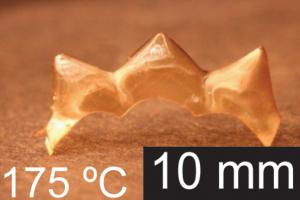
- To build their morphing device, the team used a thin film of liquid crystal elastomers – a material made of elastic polymers that also contains a crystal lattice. Polarised laser light then changes the way the units that make up the lattice are aligned. Because the crystal’s thermal properties are not the same in all directions, heating the new arrangement makes some parts of the lattice expand and others contract.
- Ordering the crystals just so makes different parts expand and contract against each other such that heating a flat sheet to 175 degrees Celsius makes it morph into a predetermined 3D shape that can be 100 times as tall as the film is thick.
- Ware thinks biomedical applications are likely to be the first out of the gate, perhaps creating easily implantable devices that can be triggered to morph once inside the body. Just as programming pushed applications for computers beyond their mathematical roots, so programmable matter might expand what our stuff can do.